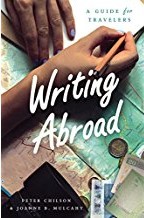Review — WRITING ABROAD: A GUIDE FOR TRAVELERS by Peter Chilson (Niger)
Writing Abroad: A Guide for Travelers
By Peter Chilson (Niger (1985-87) & Joanne B. Mulcahy
The University of Chicago Press
224 pages
$22.50 (paperback), $67.50 (cloth), $13.50 (Kindle)
Reviewed by David Arnold (Ethiopia 1964-66)
•
EDITING THE WORK of Returned Peace Corps Volunteers, I have learned that travel writing seems at first to be the easiest form of written narrative. That may be true if only you and your grandchildren are going to read it, but publishable travel writing is hard work.
Most readers of a travel story in a magazine, a book or on a blog will not pay the fare and follow that writer’s taken path. They read the story so they won’t have to go, or they use the article to decide whether to go. Usually, they go somewhere else. In the end, the traveler’s tale must be satisfying as a passive reading experience.
It takes practice to craft a piece that reveals to readers something new and let them understand and appreciate the adventure. If you can’t take a classroom course in writing with Peter Chilson at the Washington State University or his co-author, Joanne Mulcahy, who has taught at the nearby Lewis and Clark College or at Duke, you can buy this book and use it as a study guide to create something that just might be published.
Travel writing is not the regurgitation of the itinerary. Chilson and Mulcahy quote British author Peter Whitfield on the deepest value of a good narrative journey: “
. . . travel is deeply purposeful: as we move through space, we are changed, we discover, we are transformed.”
Travel writing is story-telling about a collection of little events that give you a cultural clue to the place, the structure of the face of a woman who served you espresso, a pair of careworn trousers hung out to dry, eavesdropping a political disagreement in a neighborhood bar, an unexpected encounter that changed your mind about where you were, or where you really wanted to go.
The research and the final article may include passages giving context of local history, food, politics, even topography. In any case, story-telling detail is crucial. I recall a writing teacher who described a profile he wrote about the Mexico’s national movie legend, Cantinflas. As the nation’s Charlie Chaplin went to work each morning, several assistants followed carrying bags of centavos. As he climbed several flights of stairs, the movie star reached into the bags and handed out coins to each of the dozens, perhaps more than a hundred of Mexico City’s poor.
Like any good writing, a travel story must be well written. Writing Abroad gives you the wisdom of dozens of great writers from many times and places — Jamaica Kincaid, John McPhee, Theodore White, Ibn Battatu — who have taken millions of armchair travelers on adventures of discovery. The list of experts includes some whose early experiences included the Peace Corps: Jay Davidson, Peter Hessler, Sarah Erdman, and George Packer, for starters.
This book is a summary of what Chilson and Mulcahy have learned that has worked during many years of classroom teaching: arduous cultural research, compulsive journaling, choosing the form of the narrative — using techniques of a documentary or profiles of people and setting — followed by the process of writing, revising, editing, rewriting.
This is a teaching book complete with suggested exercises in every chapter on brainstorming with a writing group, practicing how to see and smell new places, freewriting the meaning of a border, researching a shrine you have visited in the past to see what more there is to know that you missed the first time, writing profiles of people you know, just for practice. The book may be labeled a guide for travelers, but it’s also about good writing someone else will want to read.
The authors address concerns about writing for print and the Internet. And how to deal with gender. They offer the personal advice of writing pros like Steven Kurutz who spurns GPS. He argues for the use of those beautiful but cumbersome maps that fill up your dashboard and windshield when you are lost.
My own attic bears the burden of my own collection of travel and topographic maps of everything from Ethiopia’s Ogaden desert and Guatemala’s northern highlands, to the tallgrass prairies of Kansas, Oregon’s High Desert, Colorado’s Indian Peaks and the Boundary Waters north of Ely, Minnesota.
Kurutz believes you lose touch with the landscape when you follow Siri blindly, when you choose to follow the voice on your cell phone, ignore names on the road signs and zip by the stone fences and country lanes to reach your day’s destination. I wish Kurutz would tell me what to do with all of those old maps in my attic.
•
Co-authors Peter Chilson taught English as a Peace Corps Volunteer in Niger (1985-87) and is an award-winning journalist and writer of fiction; and Joanne Mulcahy founded the Writing Culture Summer Institute at Lewis and Clark University and wrote Remedios: The Healing Life of Eva Castellenoz.
Reviewer David Arnold served in Ethiopia (1964-66) and is the editor of the National Peace Corps Association’s WorldView magazine.

Well written review and the book seems like a good addition to Paul Theroux’s “The Tao of Travel.”